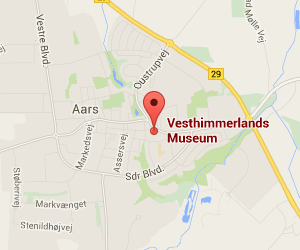Landscape of power
During the Viking Age, as well as during earlier and later times, the Limfjord Sound was the lifeblood of northern Jutland, and the ring fortress was built at the most strategically important crossing point of the fjord, from which land and water traffic had been controlled for centuries.
In the 7th century AD, the Limfjord became an important gateway for traffic between east and west, as well as between north and south. One of the consequences was the establishment of workshops, trade centres, and landing places along the coast, in fjords and inlets. The king would even gather his invasion armies on the fjord in advance of the expeditions against England and Norway.
The history of Aggersborg and Vesthimmerland is the history of the landscape of power during the Viking Age. The archaeological finds from the region demonstrate the close connection with the power elite and trading wealth associated with the Limfjord. South-east of Ranum, in the lake Vilsted Søndersø, two magnificent swords from the Viking Age were discovered in 1873 and 1917 dated to the 800s. Their blades were probably manufactured in Germany or France, whereas their handles may have been made in Norway. These two exquisite swords were extremely valuable, and must have belonged to rich and powerful families. The only Danish rune stone, other than the ones at Jelling, where Denmark is mentioned by name, is the one from Skivum Church, and it is a clear expression of the region's strong association with the Crown. In Ørbæk, money was minted during the reign of Canute the Great and his son Hardeknud, and new theories associate the burial ground at Næsby with the powerful Thrugot family. During the excavation of the Næsby cemetery, several aristocratic burials were discovered, which were dated to times before, as well as after, the establishment of the Aggersborg ring-fort. A rich horseman's grave from the first part of the 11th century is particularly noteworthy as it is thought that this may be the final resting place of Ulv Galicienfarer, the great-great-grandfather of Valdemar the Great.
During the early part of the medieval period, Vitskøl Abbey was built on land belonging to Valdemar the Great's paternal inheritance, suggesting that the land was the king's personal property. This information indicates that the region was very important and under royal control. The archaeological finds and the preserved structures suggest that the area was very wealthy until approximately 1200 AD, when the passageways through the Limfjord towards the north (Norway) and west (England and northern Europe), silted up and were blocked. The important trade route from east to west was terminated, and during the following centuries the region experienced decline and stagnation.
In the 7th century AD, the Limfjord became an important gateway for traffic between east and west, as well as between north and south. One of the consequences was the establishment of workshops, trade centres, and landing places along the coast, in fjords and inlets. The king would even gather his invasion armies on the fjord in advance of the expeditions against England and Norway.
The history of Aggersborg and Vesthimmerland is the history of the landscape of power during the Viking Age. The archaeological finds from the region demonstrate the close connection with the power elite and trading wealth associated with the Limfjord. South-east of Ranum, in the lake Vilsted Søndersø, two magnificent swords from the Viking Age were discovered in 1873 and 1917 dated to the 800s. Their blades were probably manufactured in Germany or France, whereas their handles may have been made in Norway. These two exquisite swords were extremely valuable, and must have belonged to rich and powerful families. The only Danish rune stone, other than the ones at Jelling, where Denmark is mentioned by name, is the one from Skivum Church, and it is a clear expression of the region's strong association with the Crown. In Ørbæk, money was minted during the reign of Canute the Great and his son Hardeknud, and new theories associate the burial ground at Næsby with the powerful Thrugot family. During the excavation of the Næsby cemetery, several aristocratic burials were discovered, which were dated to times before, as well as after, the establishment of the Aggersborg ring-fort. A rich horseman's grave from the first part of the 11th century is particularly noteworthy as it is thought that this may be the final resting place of Ulv Galicienfarer, the great-great-grandfather of Valdemar the Great.
During the early part of the medieval period, Vitskøl Abbey was built on land belonging to Valdemar the Great's paternal inheritance, suggesting that the land was the king's personal property. This information indicates that the region was very important and under royal control. The archaeological finds and the preserved structures suggest that the area was very wealthy until approximately 1200 AD, when the passageways through the Limfjord towards the north (Norway) and west (England and northern Europe), silted up and were blocked. The important trade route from east to west was terminated, and during the following centuries the region experienced decline and stagnation.


